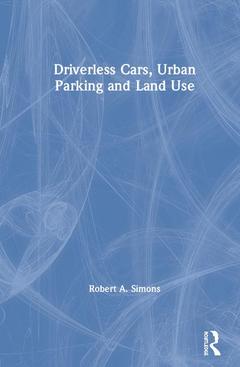Description
Driverless Cars, Urban Parking and Land Use
Author: Simons Robert A.
Language: English
Subjects for Driverless Cars, Urban Parking and Land Use:
Keywords
Transit Deserts; Autonomous vehicles; Driverless Cars; DV; vehicles; Car Insurance; AI; Electric Vehicle; artificial intelligence; Summit Hotel; Google Car; Parking Structures; zoning; Market Penetration Rates; parking; Mobility Fleet; land use; Adaptive Reuse; development; Parking Demand; real estate; Parking Industry; ethics; Parking Requirements; safety; Downtown Parking; Public Infrastructure; AV; FMVSS; Parking Spaces; Greater Cost Savings; Car Leasing; Ground Floor Retail; Home Garage; Large Buses; Self-driving Vehicles; FTE Student
Publication date: 02-2020
· 15.6x23.4 cm · Hardback
Publication date: 02-2020
· 15.6x23.4 cm · Paperback
Description
/li>Contents
/li>Readership
/li>Biography
/li>
The subject of driverless and even ownerless cars has the potential to be the most disruptive technology for real estate, land use, and parking since the invention of the elevator. This book includes new research and economic analysis, plus a thorough review of the current literature to pose and attempt to answer a number of important questions about the effect that driverless vehicles may have on land use in the United States, especially on parking. Simons outlines the history of disruptive technologies in transport and real estate before examining how the predicted changes brought in by the adoption of driverless technologies and decline in car ownership will affect our urban areas. What could we do with all the parking areas in our cities and our homes and institutional buildings that may no longer be required? Can they be sustainably repurposed? Will self-driving cars become like horses, used only by hobbyists for recreation and sport?
While the focus is on parking, the book also contains the views of real estate economists, architects, and policymakers and is essential reading for real estate developers and investors, transport economists, planners, politicians, and policymakers who need to consider the implications of a future with more driverless vehicles. Fasten your seat belt: like it or not, driverless cars will begin to change the way we move about our cities within ten years.
1: Introduction
By Robert A. Simons
2. Identification of Major Vehicle-Related Hardware and Technological Trends
By Robert A. Simons
3. Tastes and Preferences and Behavioral Change in Transportation Modal Choices and Car Ownership
By Robert Simons, Jonathan Richmond, Howard Goldberg and Daniel J. Simons
4. Government Regulation Of The Transition To Driverless/Autonomous Cars
By Robert A Simons, Tod Northman and Jeffery Carr
5. Ethical Issues From The Transition To Driverless / Automated Cars
By Robert A Simons, Tod Northman and Jeffery Carr
6: The Past Adoption and Transition Time Periods of Five Disruptive Technologies
By Robert A. Simons and Alexandra A. Malkin
7: A Road Too Steep And Too Long: The Scientific Case Against Plausible Evolution Of Driverless Cars
By Robert A. Simons
8: Any Early Signs of Softness in the Parking Markets in Capital Markets and Parking Sale Prices?
By Robert A. Simons, David C. Feltman and Alexandra A. Malkin
9: The Forward-Looking Adoption Timeline for Driverless Cars and Corporate Owned Fleets
By Robert A. Simons and Alexandra A. Malkin
10. Current Parking Regulations and Parking Market Standards in the US…
By Robert A. Simons and Samuel T. Simons
11: Urban Adaptive Reuse Potential from the Architect’s Perspective…..
By Robert A. Simons and Judson Kline
12: A Breakdown Of Parking Spaces By Type In 15 US Metropolitan Areas…
By Robert A. Simons and Liam Robinson
13: Where Would The Driverless Car Fleet Rest During The Day?
By Robert A. Simons and Alexandra A. Malkin
14: Parking At Home: Transformational Changes at the Unit and Subdivision Levels
By Robert A. Simons and Aly H. Karam
15: Policy Implications: Transition Period
By Robert A. Simons
16: Policy Implications: in the Long Run
By Robert A. Simons
17: Policy Implications and Generalizability To Large European and Asian Cities, Plus Some Final Thoughts on DV Adoption
By Robert A. Simons
18: Introduction To Parking Structure Adaptive Reuse Case Studies
By Robert A. Simons
19: The Wedge - A Parking Expansion and Adaptive Reuse Case Study In Grand Rapids, Michigan
By Robert A. Simons, Michael Ortlieb, and Josh Owens
20: The Summit, A Dolce Hotel: An Adaptive Reuse Of A Parking Structure In Cincinnati, Ohio
By Robert A. Simons and Seth Barnhard
Robert A. Simons is a professor of urban planning and real estate development at Cleveland State University, USA, in the Levin College of Urban Affairs. He is the editor of the Journal of Sustainable Real Estate, and has published over 75 journal articles and four books on real estate topics. He has served as an expert witness on over 90 legal cases, most with contaminated property issues. R.simons@csuohio.edu




